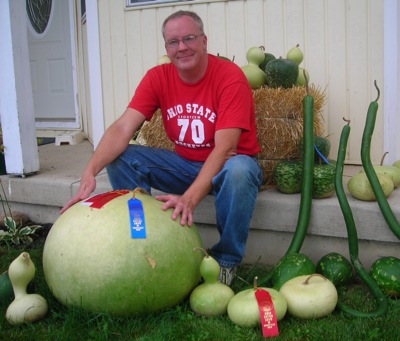Saturday, October 20th, 2007
Local gourd grower wins big
Dave Stilwell's 138-pound monster places first at the Ohio Gourd Festival
By Janie Southard

Submitted Photo
A gourd grower for more than two decades, Dave Stilwell, St. Marys, earned several ribbons recently at the 2007 Ohio Gourd Festival in Greenville. The big thrill was winning the blue ribbon for the heaviest gourd, a bushel basket variety weighing in at 138 pounds. He said it felt more like 200 pounds as he was trying to get it in his van.
ST. MARYS - When is a big gourd a really big gourd? When it weighs the most of all the entries at the 2007 Ohio Gourd Festival.
Local gourd grower Dave Stilwell, who produced the really big, 138-pound, bushel basket gourd (called that because of its shape), entered six categories at the show and placed in all of them.
The laid-back, low-key Stilwell said he wasn't crazy at first about entering his gourds and has never entered a show before.
As this giant kept growing and growing, sometimes four inches a day, he decided the ever-expanding gourd had to be some kind of record. Checking the Internet led him to the Ohio competition in Greenville.
"Because (the giant gourd) was so big and awkward, my first thought was how am I even going to get it in the van," he told The Daily Standard last week.
At his wife's suggestion, Stilwell and his son rolled the round gourd onto a blanket, picked up the edges and eased it into the van.
Does it take a lot of work to grow a giant gourd, or just gourds in general? Well, no; but it's not all a piece of cake, either.
"With the big seeds you have to soak them a few days. Then trim them before you plant ... And you can't just start seeds inside. They are definitely warm weather plants, so when you start them in the kitchen and then take them outside, they actually stunt themselves," he said.
But when the ground is warm you throw them in the ground, some in hills and others along a fence or trellis. Then they just take off on their own, he added.
"Some gourds you'll want to grow hanging, especially the ones with necks. The higher they grow from the ground, the longer the necks will be," said Stilwell, pointing out there's a category at gourd shows for the longest-neck gourd.
He's been growing gourds for more than 20 years and it all began with his mother, Susan, who owned a craft shop in Hocking Hills.
Susan Stilwell uses gourds in her crafting, but found she couldn't grow them herself because of poor soil and no sun in the forests of southern Ohio. By then Dave had moved to flat, sunny west central Ohio to become sports editor at a local newspaper.
"They grew great up here. Plus she had given me seeds for some weird variety of gourds, so it was fun seeing what would mature," Stilwell said, adding at first he does a little weeding to help the seeds along.
But after they're thriving he lets the weeds go. "The gourd vines just climb right over the weeds and where they don't the weeds act as protection from the bright sun," he said.
The big problem with gourds, which he terms "not hardy," is bugs. As the bugs appear the plants need sprayed.
After the gourds are a little bigger Stilwell sets them up so the bottom is flat - much better for crafters to work with.
Gourds were probably among the first utensils, certainly where bowls and dippers are concerned. Stilwell said ancient people grew gourds in molds to get unusual shapes. A cool drink of water from a dipper gourd on a hot day is still the practice in countless country water pumps.
Gourd rinds, seeds, utensils and ornaments have been found in the habitat of mound builders and cliff dwellers. They also hung bunches of gourds on poles around their gardens to serve as nests for insect-eating birds, according to Seminole County Library Services on the Internet.
For the prime green-gourd seeds as opposed to ornamental seeds sold in discount stores, you have to turn to the Internet, gourd shows or catalogues - Shumway is one catalogue Stilwell recommends. "Most of the packets you find on those round seed displays are pretty boring ... There really are some unusual gourds available if you just look," he said.
Drying the gourd is the next procedure and it's a bit labor intensive. Stilwell estimated it will take at least two years to thoroughly dry the big gourd. "A lot of people just give up during the drying stage because the gourd gets real moldy and ugly, but that's all part of it. When it's completely dry you can hear the seed rattling around in it. If you can't hear that, then it isn't dry.
"Once it is dry, a film appears. You then soak the gourd and then take a copper scrub brush and scrub the film off. You'll find all different colors and shades on the shell, which is very smooth. In fact, you can scratch it sideways with a knife blade and you'll never see where you touched it, the shell is that hard," he said.
Stilwell gives most of his crop to his mother. "I keep a couple of the really unusual ones. I keep one of the snake-shaped ones over the light in the kitchen. But the fun for me is the growing," he said.





